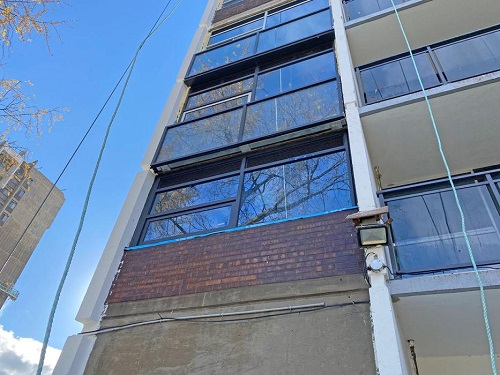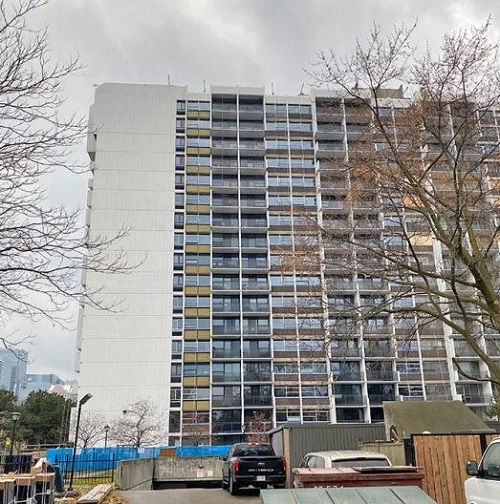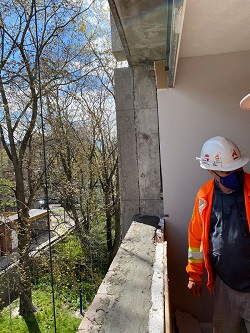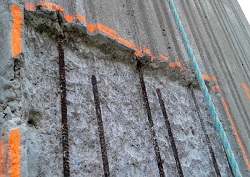January 2, 2022
Cladding solutions for aging concrete apartment towers
A major building envelope and mechanical rehabilitation now being conducted on two adjacent concrete apartment towers in Toronto, Canada is an example of how the city’s large inventory of aging concrete towers can be transformed. However, coming up with structural and sustainable restoration solutions for those post-Second World War-era buildings is neither straightforward nor easy, an in-person audience at a Buildings Show seminar was told.
Titled Over-Cladding Solutions for Toronto’s Aging Concrete Apartment Towers, the seminar featured a trio of speakers: David Collins, partner with Zeidler Architecture, Daniele Vezzoli, an associate with that firm, and Thornton Tomasetti vice-president Ken Maschke. The speakers presented a case study on Sherbourne Estates, comprised of a 23-storey and a 17-storey tower with a combined population of 590 tenants.
An extensive retrofit and overclad of the buildings got underway in 2020 and is expected to be completed sometime in 2023. The general contractor is Buttcon Limited. Other project partners include mechanical consultant Smith + Andersen and concrete restoration subcontractor SST Group. Describing the buildings as “a perfect example of brutalist architecture,” Collins said the towers were in “a state of dysfunction” and were suffering from a range of building envelope and mechanical system failures that characterize many similar buildings from the 1960s and 1970s.
“Concrete was beginning to deteriorate. Cracks were forming, water was corroding the rebar, and through many freeze thaw cycles, concrete was starting to spall and fall off the building. This spalling concrete was seen as a potential danger to both passersby at grade, as well as residents using their balconies.
“Every year the operating and maintenance budget was increasing, just to keep things in working order, and really the fixes were just Band-Aids. A major overhaul of many of these systems was required in order to prolong the life of the buildings.”
In addition to wanting to reduce those costs, the new owners were looking to reposition the buildings in the competitive Toronto market and to align them with new purpose-built rental buildings which are slowly coming on stream, said Collins.
“The owners had just purchased this development and were about to invest millions bringing it up to current market standards. As long-term holders of the property, extending its life by a minimum of 40 to 50 years seemed a reasonable goal for everyone to aim at.”

Three retrofit strategies were considered: a repair and refresh, an overclad and a reclad. Ultimately, the overclad option was selected. Overcladding the buildings and Toronto’s other post-war apartment towers is an efficient, carbon-sensitive way to reduce operational emissions from the city’s existing building stock and ensures tenant wellbeing in the face of a changing climate, he said.
But before going too much further with the envelope’s detailed design, the issue of the towers outdated gas-fired PTAC (packaged terminal air conditioner) system had to be resolved first. At some point in the past, that system had replaced an electrical one and the decision was to reconvert back to electricity to minimize disruption to the tenants. The original electric wiring was also intact, he said. Similarly, the overclad solution took into account the fact the buildings would be fully occupied during the renovation process, said Maschke.
That process consists of three main components: overcladding the brick knee walls, the area below the bedroom windows, and associated exposed concrete slab edges with a curtain wall type assembly in front of those knee walls; replacing all of the existing windows and patio doors with double-glazed argon-fill new ones; and repairing the exposed concrete shearwalls and coating them with a high-performance protective coating, he said.
An “architectural expression” has been created by the overclad, bringing them in line with new apartment buildings and condominiums, while acknowledging their structural concrete origins, said Collins. (Source: Thornton Tomasetti)

|

Prior to windows being installed, mortar on the existing knee walls is repaired and smoothed. (Image: Zeidler)

Using a swing stage, crews carefully removed chipped concrete to prepare for the restoration and coating. This image shows the underlying rebar in one of the large slabs that make up the towers’ shear walls. (Image: Zeidler)
|
|
|